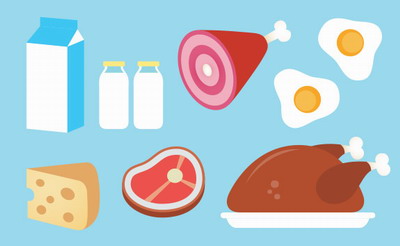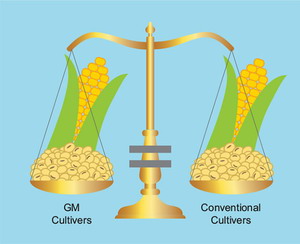Are animal products from livestock fed with Genetically Modified feed safe to eat?
As highlighted in previous newsletters, genetically modified (GM) crops as food are becoming increasingly consumed worldwide. They have a number of benefits for producer and some for consumers as well and those in international trade have shown to be safe. But what about as feed for animals, are they also safe for livestock and what about humans that eat these livestock?
Livestock and feed crops
Livestock produce wide range of food products for human consumption, including meat, milk and eggs. They contribute about one sixth of food energy and one fourth of food protein worldwide, therefore are vital in providing nutrition and food security for people.

Figure 1. Livestock produce wide range of food products for human consumption.
To produce enough livestock for human consumption, large area of land is devoted to livestock grazing and feed crop production.
Importance of GM Feed crops
The hectarage for planting GM crops has continued to increase over the years, from 1.7 million hectares in 1996 to 181.5 million hectares in 2014. In fact a significant proportion of food crop has now been GM, according to figures released by the Global GMO compass (2016), the proportion of GM corn and GM soya bean of global production in 2013 has reached 32% and 79% respectively. As corn and soya beans are commonly used to feed livestock to provide them with energy, protein and oil, livestock populations have been the major consumers of GM crops.
Why farmers are shifting towards GM crops? GM technology has brought higher nutritional value and increase yield of food crops. The properties introduced to plants may make the crops resistant to diseases caused by insects or viruses, tolerant to herbicides or supply better nutrition such as increased oleic acid level in soya beans.
Safety Assessment of GM Feed
All the GM cultivars available on the international markets have been approved by food safety regulatory authorities based on lengthy and detailed safety assessment relating to human health. Safety assessment of GM food crop for human consumption and GM feed crop for animals share the concept of "substantial equivalence" (OECD, 1993)

Figure 2. Safety assessments of both GM food crop and GM feed crop are based on the concept of "substantial equivalence".
We all agree that conventional crops are considered safe by the long history of consumption as food or feed. "Substantial equivalence" calls for a comparative assessment process to identify similarities and differences between GM crop and its conventional comparator crop with an acceptable level of safety. The process includes characterizing the introduced gene, assessing its stability and assessing the changes it brought onto the GM plant, including both intended and unexpected changes . The new physical and nutritional characteristic in the newly modified GM plant should also be compared with its non-GM counterpart. Apart from the "Substantial equivalence" assessment, many regulatory agencies worldwide including the Codex also follows other ideas in the consensus document by Organisation for Economic Co-operation and Development on GM feed crop (OECD 2003) which suggests that the safety assessment of animal feeds must also consider any risk to the animals that consume the feed and any indirect risk to human consuming these animal products such as meat, milk and eggs, therefore animal feeding studies or testing on animal products may be conducted depending on the situations. Individual f eed crop is also assessed on a case by case basis depending on the nature of food and the genetic changes involved.
Safety of GM animal products
Issue of concern for human heath associated with the use of GM feeds include whether the modified DNA and proteins expressed in the GM feed crops would be transferred along the food chain and accumulate in milk, meat and eggs. Some people may ask, "If a modified genetic material is harmful to us, will it then be potentially absorbed in our gut and integrated into our bodies posing deleterious consequences?"
The European Food Safety Authority (EFSA) reported the fate of modified DNA or proteins in animals fed with GM feed in a literature survey. EFSA concluded that DNA and protein of the GM crop were rapidly degraded into small fragments in the digestive tract of animals and humans. Experimental studies with livestock also showed that DNA or proteins derived from GM feed had not been detected in edible animal products from farm animals.
Many other studies and reviews on the safety of GM feed have also come to a similar conclusion that the modified DNA and proteins of GM crops were digested and absorbed in the same way as their conventional comparators, and subsequently modified DNA and protein have not been detected in meat, milk and eggs or organ tissues of livestock fed with GM feed. Therefore consuming animal products from animals fed with GM crops is safe for humans.
Conclusion
It is likely that GM crops will become increasingly important as feedstuffs for livestock due to the various benefits provided to farmers and consumers. To date, we are not aware of any scientific evidence that suggest consuming animal products from livestock fed with GM crops is anything other than as safe as those derived from livestock fed conventional crops. Meat, eggs and milk produced from livestock raised with GM feed can be safety consumed by the public.